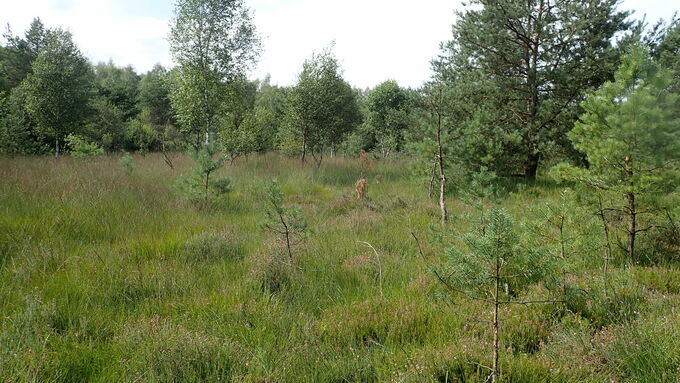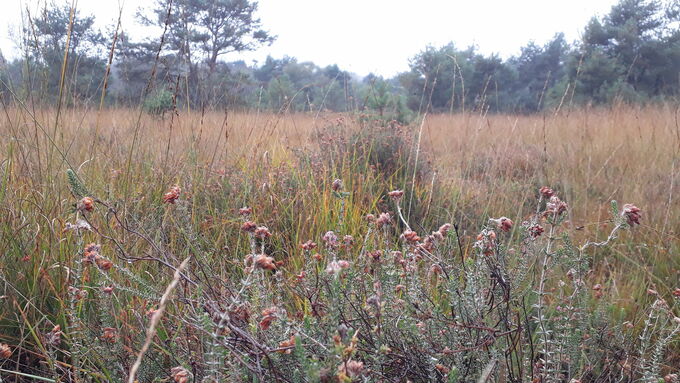‘Hellehornheide’ had become increasingly overgrown in recent years. © Leonie Braasch, NLWKN
download picturemain content
Project of the month
#8/2022 THE ‘HELLEHORNSHEIDE’ IS KISSED AWAKE
Habitat protection in the SAC Gildehauser Venn (district of Grafschaft Bentheim)
The habitat type ‘Northern Atlantic wet heaths with Erica tetralix’ (4010) often occurs in transitional areas on bog soils or half-bog sandy soils. It was able to expand especially during historical heath farming. Nowadays, however, due to drainage, ploughing, fertilisation and conversion to grassland, arable land and forestry, wet heaths can only be found at selected sites in the North Atlantic region.
The Gildehauser Venn in the district of Grafschaft Bentheim is one of the special areas of conservation (SAC) in the Atlantic region of Lower Saxony with the largest occurrences of this habitat type. However, in many places the wet heaths are in a poor conservation status. In recent decades, the lower nature conservation authority of the district of Grafschaft Bentheim has initiated massive woodland works here to promote the habitat type 4010 and other habitat types. In the third project phase of the LIFE IP Atlantic Region DE, a hidden part of the SAC is being focused upon: The area ‘Hellehornsheide’ is to be restored to an open area with wet heath. The owner, the Bertha Jordan-van-Heek Foundation, has agreed to this action.
In the ‘Hellehornsheide’, the typical species bog heather (Erica tetralix) as well as the brown beak-sedge (Rhynchospora fusca) and various sedge and rush species have been currently still detected. Thus, there is hope that these species will spread again through targeted measures and that the situation for the wet heath will improve significantly. At the beginning of 2022, the tracked excavator therefore rolled into the south-east of the ‘Gildehauser Venn’ for woodland work in order to clear about five hectares of open land overgrown with pines and birches. Areas where the bog-myrtle (Myrica gale) has been found were thinned out very carefully by motorised thinning. Almost 850 cubic metres of wood chips were removed from the area. In areas with high needle litter, the tracked excavator carefully removed the top layer in small areas so that the heath may germinate.
As the open land is dominated in parts by purple moor grass (Molinia caerulea), a small-scale mulching of the moor grass stands will be carried out in late summer 2022. The mulch layer will then be stripped off and removed from the area. In the future, ‘Hellehornsheide’ shall be included in the sheep grazing regime of the ‘Gildehauser Venn’, as regular maintenance is essential for the preservation of the area.
Related topics
Further links
- Nature reserve ‚Gildehauser Venn‘ – Niedersächsischer Landesbetrieb für Wasserwirtschaft, Küsten- und Naturschutz (in German) (external link opens in a new window)
- Implementation notes for the habitat type 4010 - Vollzugshinweise Feuchte Heiden mit Glockenheide (LRT 4010) - Niedersächsischer Landesbetrieb für Wasserwirtschaft, Küsten- und Naturschutz (in German) (external link opens in a new window)
- District of Grafschaft Bentheim – Department for Nature and Landscape (in German) (external link opens in a new window)





